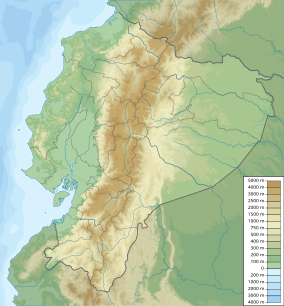Sangay National Park
| Sangay National Park | |
|---|---|
| Parque nacional Sangay | |
IUCN category II (national park) | |
 Sangay National Park | |
| Location | Ecuador |
| Coordinates | 1°50′S 78°20′W / 1.833°S 78.333°W |
| Area | 5,177.65 km2 (1,999.10 sq mi) |
| Established | 1979 |
| Type | Natural |
| Criteria | vii, viii, ix, x |
| Designated | 1983 (7th session) |
| Reference no. | 260 |
| Region | Latin America and the Caribbean |
| Endangered | 1992–2005 |
Sangay National Park (Spanish: Parque Nacional Sangay) is a national park in Ecuador. It is in more than one province: Morona-Santiago, Chimborazo, Tungurahua, Cañar, and Azuay. The park has two active volcanoes (Tungurahua and Sangay), and one volcano that does not erupt any more: El Altar (Kapak Urku). The park is from 900 to 5,319 meters (2,953 to 17,451 ft) above sea level. Sangay National Park has many different kinds of places: ice sheets, volcano ground, tropical rainforests, cloud forests, wetlands, grasslands, and one of the largest páramo mountain grasslands in Ecuador.[1] It has 327 lakes, and its wetlands covering 31.5 square kilometers (12.2 sq mi).[1]
The park is a UNESCO World Heritage Site, listed in 1983.[1] In 1992, it was added to the List of World Heritage in Danger because people sneak in to kill animals against the law, extensive animals eating grass, people making roads, and people doing things too close to or inside the park. It was removed from the UNESCO list of endangered sites in 2005.
Name
[change | change source]The word "sangay" comes from the Shuar language word samkay, or "volcano."[2]
Living things
[change | change source]Because the park has many different kinds of places for plants and animals to live, there are many different plants and animals there.[1] It has more than 3,000 species of flowering plants, more than 430 birds, 107 mammals, 33 amphibians, 14 reptiles, and 17 fish species.[1]
Many rare animals live in the park, for example, the mountain tapir and spectacled bear. The mountain tapir is in danger of dying out, and the park is important to keeping it alive.[3] Spectacled bears, giant otters, jaguars, ocelots, margays, Brazilian tapirs, white-tailed deer (Odocoileus virginianus ustus), little red brocket deer, and Northern pudu live in forests in the park. People have seen the cougar and pampas cat in the park too.[4] Caenolestes sangay, a species of shrew opossum, was originally described in 2013 from specimens collected from Sangay National Park.[5]
Over 400 species of bird live in the park.[6] BirdLife International says this park is an Important Bird Area.[7] The Andean Condor and Andean Cock-of-the-rock both live in the park.[1]
In 2016, scienitsts found a frog that no one had written science papers about before. They named it Pristimantis tinguichaca.[8]
Gallery
[change | change source]-
Tungurahua volcano in 1999
-
Sangay from the air
-
Sangay
References
[change | change source]- ↑ 1.0 1.1 1.2 1.3 1.4 1.5 "Sangay National Park". UNESCO World Heritage Centre. United Nations Educational, Scientific, and Cultural Organization. Retrieved 5 September 2021.
- ↑ Julio César Carrión (February 27, 2022). "Osteocephalus sangay". AmphibiaWeb (in Spanish). University of California, Berkeley. Retrieved July 24, 2022.
- ↑ Downer, CC. (1996). "The mountain tapir, endangered 'flagship' species of the high Andes". Oryx. 30 (1): 45–58. doi:10.1017/s0030605300021384.
- ↑ Nowell, K.; Jackson, P. (1996). Wild Cats: Status Survey and Conservation Action Plan (PDF). Gland, Switzerland: IUCN.
- ↑ Ojala-Barbour, R.; Pinto, C.M.; Brito, J.; Albuja, L.; Lee, T.E.; Patterson, B.D. (2013). "A new species of shrew-opossum (Paucituberculata: Caenolestidae) with a phylogeny of extant caenolestids". Journal of Mammalogy. 94 (5): 967–982. doi:10.1644/13-MAMM-A-018.1.
- ↑ UNEP & WCMC: SANGAY NATIONAL PARK ECUADOR, (letztes update 2005) PDF[permanent dead link]
- ↑ "Sangay National Park". BirdLife Data Zone. BirdLife International. 2021. Retrieved 21 January 2021.
- ↑ Brito M, J.; Ojala-Barbour, R.; Batallas R, D.; Almendáriz C, A. (2016). "A New Species of Pristimantis (Amphibia: Strabomantidae) from the Cloud Forest of Sangay National Park, Ecuador". Journal of Herpetology. 50 (2): 337–344. doi:10.1670/13-103. S2CID 55346001.




